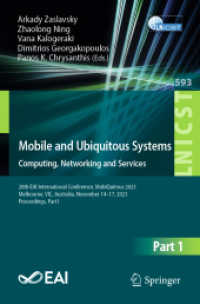- ホーム
- > 洋書
- > ドイツ書
- > Humanities, Arts & Music
- > History
- > antiquity
Description
(Short description)
Die Casa del Fauno (VI 12) zählt zu den größten und am besten ausgestatteten Häusern der vom Vesuv verschütteten Stadt Pompeji. Ihre Freilegung und Erforschung reicht bis in das Jahr 1830 zurück. Stratigraphische Ausgrabungen unter den Böden des Hauses fanden in den Jahren 1961 und 1963 statt und brachten zahlreiche Funde und Befunde. Darüber hinaus wurde die späthellenistisch-frühkaiserzeitliche Architektur des Hauses ebenso wie die ältere Siedlungsgeschichte detailliert untersucht. Die integrierte Analyse zeigt eine Besiedlungsgeschichte ab dem späten 6. bzw. frühen 5. Jahrhundert v. Chr. und liefert differenzierte Daten zur Bauentwicklung des Hauses vom 2. Viertel des 2. Jahrhunderts v. Chr. bis in die Spätzeit der Stadt.
(Text)
The Casa del Fauno (VI 12,2) is among the largest and most wellfurnished Pompeian houses buried by the eruption of Mount Vesuvius in 79 AD. This volume presents the results of excavations undertaken within and under the floors of the house, presenting a thorough architectural history of the building. Additionally, a large number of stratified finds allows for the reconstruction of Pompeii's settlement history as far back as the late 6th century BC
(Review)
on the methodical archaeological pedigree it deserves."
Michele George
In: American Journal of Archaeology. 115.1 (January 2011)
Februar 2011)
------------------------------
"The (unfair) question some specialists will be tempted to ask, of course, is whether Faber and Hoffmann's work lives up to the expectations raised by the long time it cost them to produce it. The response to that question must be twofold. On the one hand, the book will undoubtedly prove a highly valuable contribution to Pompeian debates for decades to come; on the other hand, as one might expect, the length of the process in the end turns out to be a handicap rather than a blessing (...)
The main contribution of the work lies in the detailed publication of the excavation finds. (...)
Yet, one should not be too unfair with this book. It is very easy to criticize its approach and methodology from a postmodern, early twenty-first century perspective. This book simply does not belong to the twenty-first centu
(Author portrait)
Andrea Faber studierte Provinzialrömische Archäologie, Vor- und Frühgeschichte und Alte Geschichte und war Hörerin der Klassischen Archäologie. Magister und Promotion an der LMU München. Ab 1993 Forschungsstipendium des Deutschen Archäologischen Instituts, Berlin, für die Bearbeitung der Grabungsbefunde und Funde aus der Casa del Fauno in Pompei/Italien im Institut Rom und in der Soprintendenza Archeologico di Pompei. Habilitation an der Universität Köln mit einem Thema zum Kulturwandel in Süditalien zwischen den Samnitenkriegen und der frühen Kaiserzeit. Privatdozentin des Archäologischen Instituts Köln, derzeitiger Forschungsschwerpunkt in den nördlichen römischen Provinzen.
(Review)
t always take at face value any more, but which they nevertheless use frequently because they most fully express a 'traditional' point of view, which is about to be challenged and refined. In that sense, the position of the book may be comparable to that of Jongman's "Economy and Society of Pompeii," or Mouritsen's "Magistrates, Elections and Municipal Elite" (which both were published in 1988). In other words: finally, we have a fully expressed 'traditional' view on the history of the largest house of Pompeii. That is a great contribution to scholarship. Now, let's use it, and challenge it."
Miko Flohr
In: Göttinger Forum für Altertumswissenschaft. 13 (2010). S. 1165-1171.
(12. November 2010)







